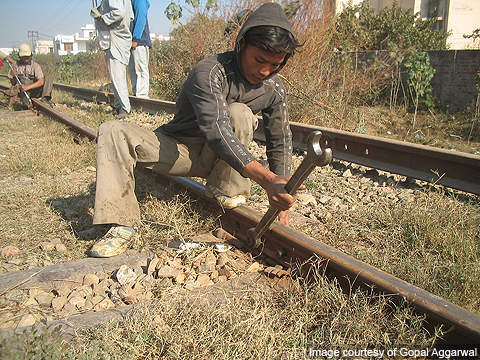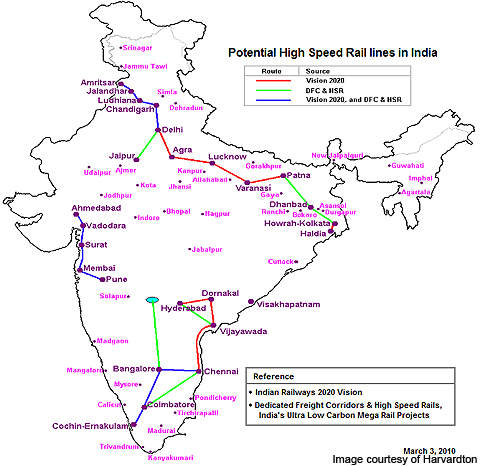The Ministry of Railways, under the direction of the Indian Government, had taken up the dedicated freight corridor (DFC) project. The project involves the construction of six freight corridors traversing the entire country. The purpose of the project is to provide a safe and efficient freight transportation system.
Initially, the construction of two freight corridors, the Western DFC connecting the states of Haryana and Maharashtra and the Eastern DFC connecting the states Punjab and West Bengal, is being undertaken. The combined length of the Western and Eastern DFCs is approximately 2,843km. The total cost of the project is estimated at $11.38bn. It is expected to become operational between 2019 and 2021.
The other four corridors include North-South (Delhi-Tamil Nadu), East-West (West Bengal-Maharashtra), East-South (West Bengal-Andhra Pradesh) and South-South (Tamil Nadu-Goa). These four corridors are still in the planning stage.
In 2006, the Government of India established a dedicated body to implement the project, called the Dedicated Freight Corridor Corporation of India (DFCCIL). The DFCCIL began building the eastern and western corridors simultaneously, in three phases. Construction work on phase one of the project, which includes the 105km Sonnagar-Mughalsarai section of the Eastern DFC, began in February 2009.
The DFC project is expected to reduce congestion at various terminals and junctions. It will allow for efficient and fast movement of freight along the corridor.
The total land required for the corridor is 11,180ha, but initially, the DFCCIL has a notification for only 5,000ha, across eight states. The final notice for the possession of land under section 20E of the Indian Railways (Amendment) Act gives the project power to acquire land as it is of national importance. Approximately 6,000ha of land has been notified by DFCCIL under this section.
However, the Railway minister’s resolution not to acquire the land forcibly hindered the project and forced the DFCCIL to re-examine the alignment of corridors. This is expected to result in time and cost over-runs, and freight choking on both the corridors.
The bidding process for the eastern corridor, which was scheduled for May 2010, was also postponed.
By the end of November 2019, DFCCIL allocated 4,419ha of land for Eastern Corridor, excluding Sonnagar-Dankuni section, which was allocated 918ha. The Western Corridor was allocated 5,985ha.
Dedicated freight corridor project
The DFC project was first proposed in April 2005 to address the needs of the rapidly developing Indian economy. The existing quadrilateral railway network, also known as the golden quadrilateral, which links the major metropolitan cities of Delhi, Mumbai, Chennai and Kolkata, is unable to support the growing demand due to capacity constraints. A dedicated freight corridor was required to address these concerns.
Several large coal mines and steel production facilities are located along the proposed Eastern DFC line. Container traffic is also predominant along the Western DFC route, arriving mainly from the Jawaharlal Nehru Port (JNPT). By 2022, the port is expected to handle 5.29 million 20ft-equivalent units of container traffic.
In January 2006, RITES, an engineering consultancy set up by the government, submitted a feasibility report for the two corridors. RITES proposed the route and length of the corridors. The Eastern DFC is 1,337km and extends from Ludhiana in Punjab to Dankuni in West Bengal, while the Western DFC extends for 1,506km from Dadri in Haryana to JNPT in Maharashtra.
The project is being executed in several phases. Phase one included a 920km segment of the western corridor between Rewari in Haryana to Vadodara in Gujarat. The 105km Sonnagar (Bihar) to Mughalsarai (Uttar Pradesh) section and the 710km Mughalsarai to Khurja (Uttar Pradesh) segment of the eastern corridor are also part of phase one.
Approximately 67% of the construction costs of the Western DFC is funded by a soft loan of $4bn provided by Japan International Cooperation Agency. The remaining funds are provided in equity by the Ministry of Railways. The Eastern DFC is constructed through funds received from the World Bank and the Ministry of Railways.
The World Bank agreed to finance 1,192km of the Khurja-Kanpur, Khurja-Dadri, Kanpur-Mughalsarai and Khurja-Ludhiana sections. The remaining portion between Mughalsarai and Sonnagar is funded by the Ministry of Railways. The Sonnagar-Dankuni section received financing through a public-private partnership.
A contract for the construction of the 105km Sonnagar-Mughalsarai section was awarded to the Gurgaon-based C&C Constructions in December 2008. Another contract for the construction of 54 bridges on the Western DFC was awarded to Hyderabad-based Soma Enterprises.
The Sanehwal-Khurja section on the eastern corridor was tendered on a design-build basis. Two contracts were awarded, one for the civil structure and track works and the second for the system works.
Eastern DFC line routes
The route of the Eastern DFC running from Ludhiana to Dankuni passes through Asansol, Gomoh, Sonnagar, Mughalsarai, Kanpur, Khurja and Saharanpur. The 426km Ludhiana to Khurja section of the eastern DFC is a single electrified line, while the rest of the corridor is electrified automatic double line.
To connect the corridor with major industrial centres, several hubs or junctions have been planned along the corridor. The junctions will be located in places such as Ganjkhwaja, Jeonathpur, Naini / Cheoki, Prempur, Bhaupur, Tundla, Daudkhan, Kalanaur, Rajpura, Sirhind and Dhandarikalan.
The Dadri to JNPT route of the Western DFC will pass through Vadodara, Ahmedabad, Palanpur, Phulera and Rewari. This section of the corridor will be a double-line electric track. The corridor also includes another 32km single line from Pirthala to Tughlakabad.
DFC project infrastructure
The Eastern DFC plan includes the construction of 104 bridges, 368 road-over-bridges (ROBs), 189 road-under-bridges (RUBs) and 21 flyovers. It also includes the reconstruction of nine existing ROBs and the extension of ten existing RUBs.
The Western DFC plan includes a 4km-long tunnel, 262 bridges, 33 flyovers, 505 ROBs and 200 RUBs. The western corridor also includes the reconstruction of 24 existing ROBs and lengthening ten existing RUBs.
A total of 211 bridges were completed and 145 are in progress as of the end of November 2019. In addition, 271 RUBs were commissioned out of 562 and 259 were in progress. Out of 296, 67 ROBs have been completed and 138 are in progress.
Corridor signalling and communications
Automatic signalling with 2km spacing between signals will be used for both corridors. The Ludhiana-Khurja segment of the Eastern DFC will additionally feature an absolute block system. Traffic control communications on the two corridors will feature an independent OFC system. A GSM-R communication system will be adopted for mobile train radio communication.
DFC rolling stock
The project will use single-stack containers on the Eastern DFC and double-stack containers on the Western DFC. The containers will be driven by electric locomotives on the Eastern DFC and diesel locomotives on the Western DFC. The maximum speed of the locomotives will be 100km/h.






